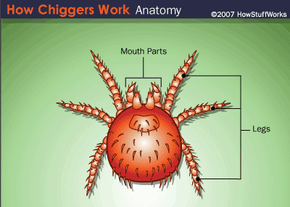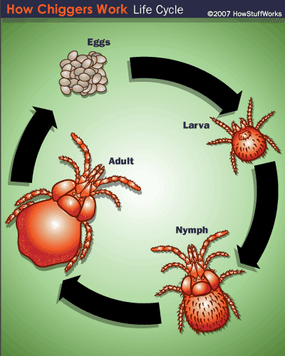Quck answer
Chiggers are tiny mites that live in grassy and wooded areas. They attach themselves to humans and animals and feed on their skin cells. The bites can cause intense itching and inflammation. Chiggers inject digestive enzymes into the skin, which break down the skin cells into a liquid that they can consume. The itching and redness that occur are an allergic reaction to these enzymes. Prevention involves wearing protective clothing and using insect repellent. Treatment includes washing the affected area with soap and water and applying anti-itch creams or ointments.
Wild Animals
Introduction to Chiggers

Many people wrongly believe that chiggers are blood-sucking insects like fleas, ticks, or mosquitoes, but this is not true. The first problem with this belief is that chiggers are not insects, and the second is that they do not feed on blood. Chiggers are actually the larvae of harvest mites, and they consume the cells of their host’s skin.
Harvest mites are arachnids, meaning that they are related to ticks and spiders. The adults are tiny and red, with eight legs, and they live in the soil, so they are often found while digging in yards or gardens. Adult harvest mites feed on other insects and their eggs, and they can be beneficial to humans since they eat the eggs of other pests such as mosquitoes.
However, harvest mite larvae are different. They are also red, but have six legs instead of eight, and they are parasites that need to consume the tissues of living animals to survive. They are too small for a person to see, but groups of them may be visible on the skin.

The larvae hatch from spherical eggs laid by adult females on the ground. Harvest mites lay all their eggs in one spot, so infestations can be extremely localized. One patch of weeds might be full of newly hatched chiggers while a nearby patch has none.
After having one complete meal, harvest mite larvae fall to the ground and become nymphs. Nymphs are not parasites, but instead, they feed on insect eggs. The nymphs mature into adults, and the cycle begins again with a new set of eggs.
There are thousands of species of harvest mites living worldwide, with different species found in different regions. Some species, including Trombicula alfreddugesi, Neotrombicula autumnalis, and Leptotrombidium deliense, can be a nuisance to humans. Leptotrombidium deliense is common in parts of Asia and can carry scrub typhus, a fatal bacterial disease that can be treated with antibiotics. Chiggers in other regions are not known to transmit diseases to humans.
Regardless of their species, most chiggers use the same method to find food. Next, we will discuss how chiggers locate their prey and how they feed on them.
FAQ
1. What are chiggers?
Chiggers are tiny, red mites that belong to the Trombiculidae family. They are also known as harvest mites or scrub-itch mites. Chiggers are found in grassy areas, forests, and other vegetation-rich environments. They feed on the skin of humans and animals and can cause intense itching and redness.
2. How do chiggers bite?
Chiggers do not actually bite, but they attach themselves to the skin using their mouthparts. They then inject a digestive enzyme that breaks down skin cells, which they can feed on. The enzymes cause an immune response in humans, resulting in itching and redness.
3. What are the symptoms of chigger bites?
The most common symptom of chigger bites is intense itching, which can start within a few hours of being bitten. The affected area may also become red and swollen. In severe cases, blisters may form. Chigger bites are usually found in areas where clothing is tight-fitting, such as around the waistline, ankles, and behind the knees.
4. How can you prevent chigger bites?
To prevent chigger bites, it is best to avoid areas where they are known to be present. If you must be in an area with chiggers, wear long pants and sleeves, tuck your pants into your socks, and use insect repellent on exposed skin. After being outside, take a shower and wash your clothes in hot water to remove any chiggers that may have attached themselves to you.
5. How are chigger bites treated?
The best way to treat chigger bites is to relieve the itching and prevent infection. Over-the-counter anti-itch creams and calamine lotion can help relieve itching. Avoid scratching the affected area, as this can lead to infection. If the bite becomes infected, seek medical attention.





Leave a Reply